Give your food life! This simple tutorial teaches you about sprouted almonds. Boost the nutrition in your diet by sprouting nuts, beans, and grains! Great for added protein in homemade smoothies.
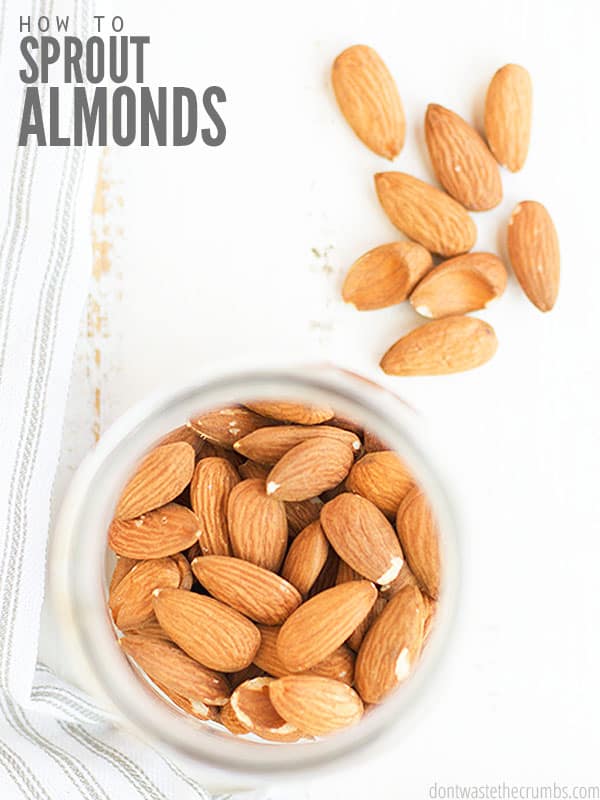
It never occurred to me to consider whether the food I was eating was dead or alive.
Have you?
On Saturday night, we had rotisserie whole chicken, roasted potatoes, broccoli salad, green salad, blue cheese, and black pepper focaccia (which was an AMAZING flavor combination, by the way).
The only foods I can wrap my head around being alive are the chicken, bacon from the broccoli salad, and the cheese (because it came from milk and the milk came from cows).
Apparently, there are some foods that are better for you when eaten raw, unlike chicken.
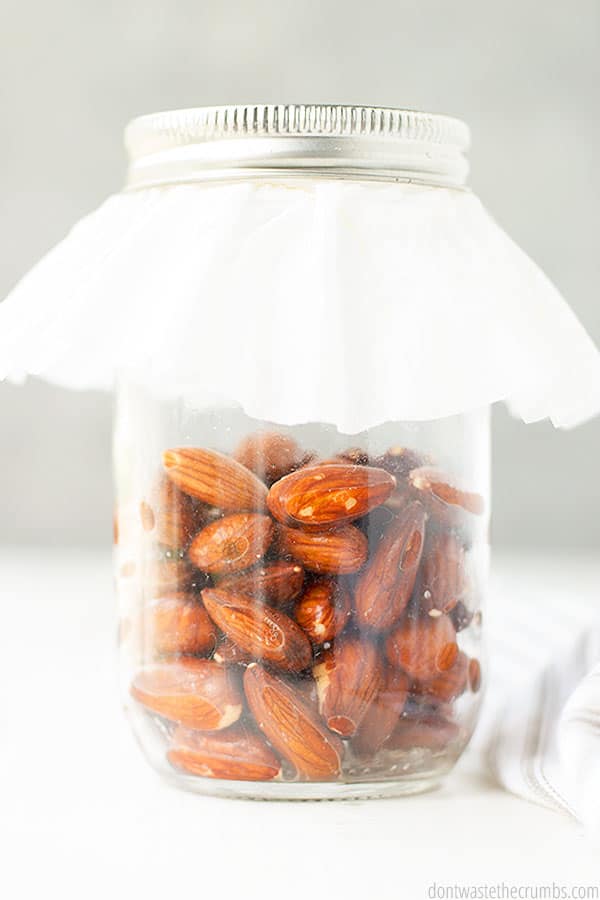
Benefits of Sprouted Almonds
Seeds, grains, nuts, and beans we find in stores were once “alive” plants. They all come from trees or plants or stalks of some sort and when they were alive, they contained active enzymes. These enzymes caused the vitamins and minerals to help the plant grow and produce the food we recognize.
When the foods are picked or harvested, enzyme inhibitors take over and block the enzymes. Consider it nature’s way of protecting the food’s ability to grow and reproduce until the conditions for germination are right. What we are left with is food that contains enzymes in a not-so-helpful, dormant state.
It doesn’t sound like a big deal – so what if the seeds are preventing themselves from germination? We’re just trying to make bread right? Not grow stalks of wheat.
What we fail to realize is that active enzymes increase vitamin content dramatically (Vitamin B and carotene) and even produce some vitamins that are not available when the enzyme inhibitors are in place (Vitamin C).
- Remember the issue with phytic acid? It’s also present in seeds, grains, nuts, and beans and it hinders absorption of several key minerals. It almost seems like these foods shut down once they’re harvested. Minerals are blocked, vitamins are diminished and even cease to exist and our bodies recognize this too.
- Ever have problems digesting grains (and not because of gluten)? I have. Just these past two weeks my gut has been a little bit more disturbed after eating wheat bread (homemade, but no sprouting or soaking).
- Experience a bit of flatulence when eating beans? Let me tell you… eating beans every Thursday will clearly let you know whether or not they are the culprit of excessive gas. Like clockwork, the magical fruit on Thursday means a bit of tooting on Friday. And the effects continue if we have leftovers for lunch. (Unless I implement this method of soaking before I cook.)
Sprouting seeds, grains, nuts and beans can give life to our dead food and help alleviate these problems and provide so many other benefits:
- Produces Vitamin C
- Increase in vitamins B2, B5 and B6
- Increases carotene
- Neutralizes phytic acid
- Breaks down complex sugars that cause intestinal gas
- Neutralizes enzyme inhibitors
- Predigests some starches into sugar
- Inactivates the potent carcinogen aflatoxin
- Produces additional enzymes that aid in digestion
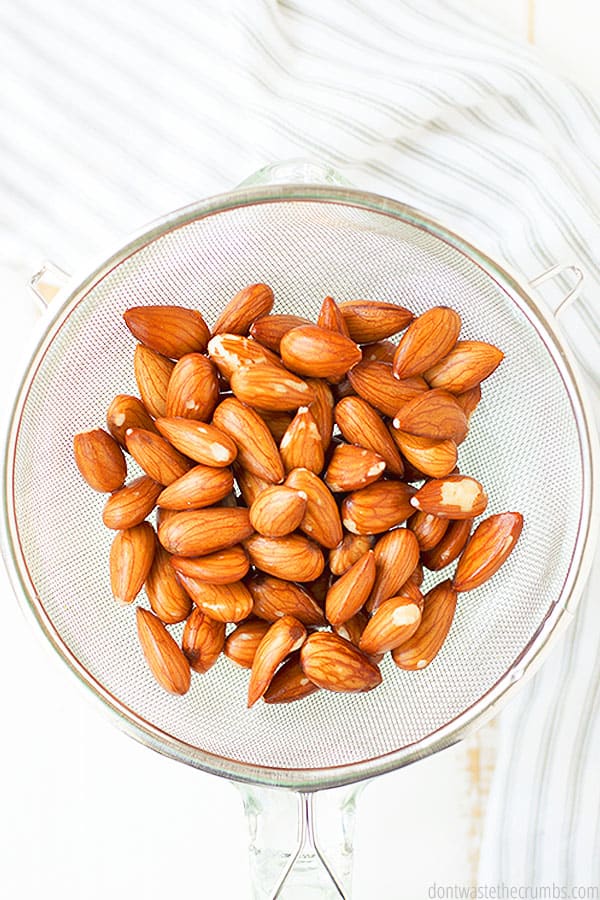
The Sprouting Process
For all the benefits that it provides, sprouting is really, really easy. Easier than making a sourdough starter, and that’s REALLY easy!
The process is the same for all seeds, grains, nuts, and beans: soak, rinse, wait; rinse, wait, and repeat.
Since I’m more of a visual person and everyone likes pictures, here’s the photo process of sprouting almonds:
Ingredients for Sprouted Almonds
- 2 cups of raw almonds
- Filtered water
- Quart jar with lid
- Coffee filter
- Small bowl
Method for Making Sprouted Almonds
Note: Even though these photos are a little older, I’d like to show you them anyway so you can see the step-by-step process of sprouting almonds.
Measure almonds into a quarter jar.
Fill with filtered water and cover with a coffee filter, securing with just the ring of the lid. Allow the jar to sit on the counter overnight.
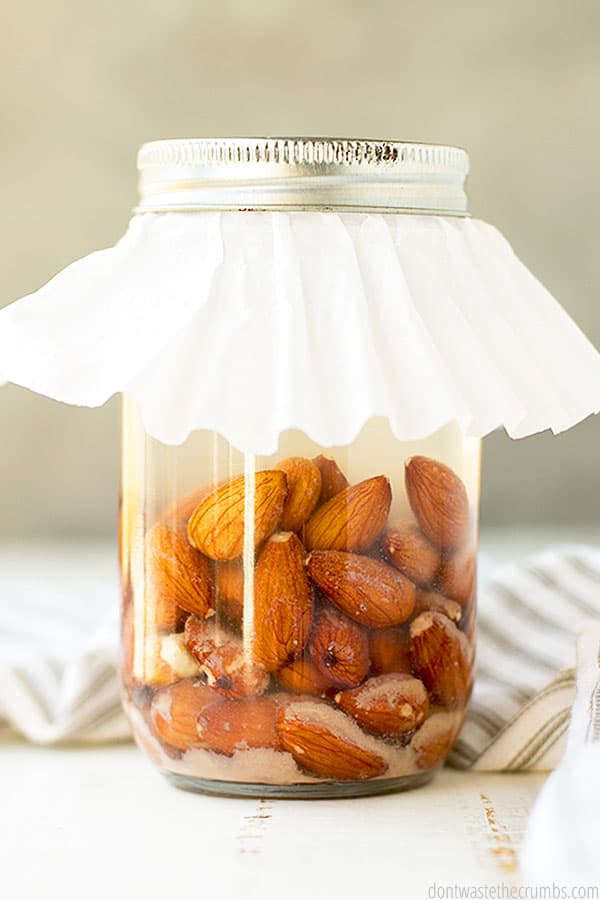
The next morning, remove the ring and coffee filter and drain the water from the quart jar. Fill the jar again with fresh filtered water, swirl the almonds, and drain the water. Replace the coffee filter and ring and using a small bowl, store the jar at an angle so excess water can drain out and air can circulate inside the jar.
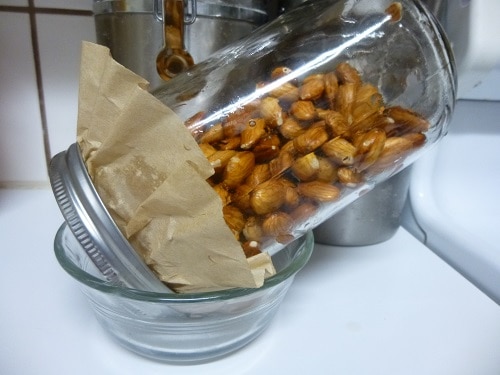
Repeat the above step each morning and night until the almonds begin to sprout.
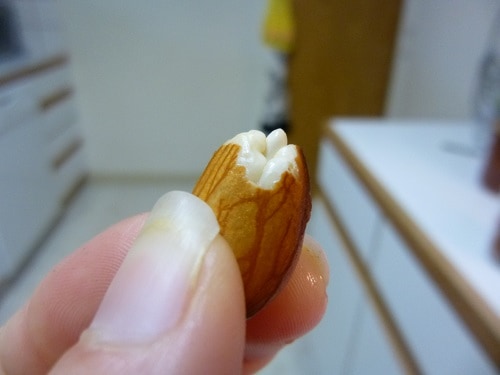
The above picture was after only one day of soaking. Here are some additional pictures of the process.
This is the jar of almonds after one day.
Little sprouts are trying to poke through the tips of the almonds.
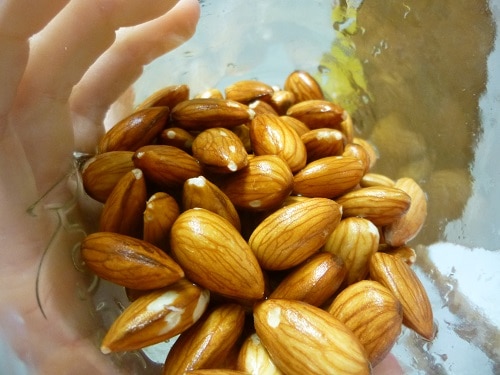
Here’s another almond beginning to sprout after day two.
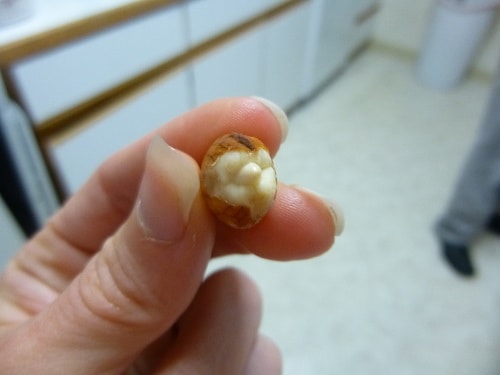
After two days, the almonds were beginning to swell up.
You can see how the almond is beginning to outgrow its shell, so to speak – seen by the cracks at the bottom and along the sides.
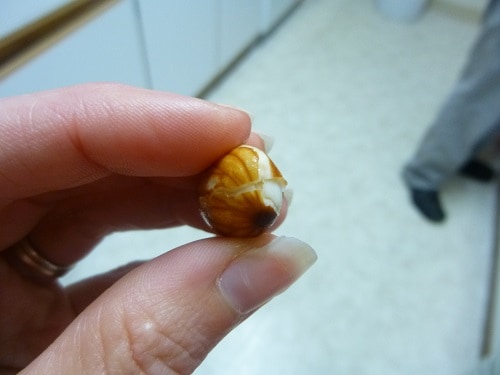
If you crack open a sprouting almond, this is what you’ll find.
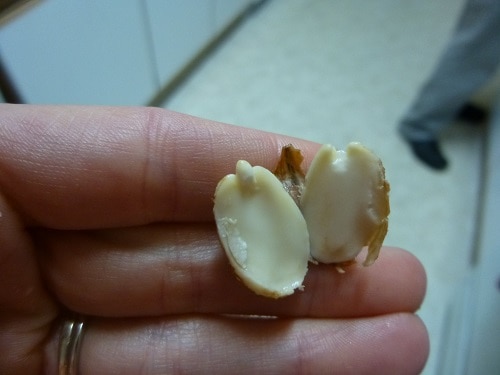
Once all the nuts are sprouted, store them in a jar in the fridge for a few days or dehydrate them into crispy nuts.
The sprout itself will look different depending on what seed, grain, nut, or bean you’re sprouting. Some grains will produce small, white sprouts. Lentils are fully sprouted when the “tail” reaches 1/4″. Mung beans will grow 2″ long sprouts!
The process works with nearly every seed, grain, nut, and bean, with just a few minor exceptions:
- Flax seeds become too moist and sticky.
- Oat seeds will not sprout since they’re separated from their outer hull.
- Pecans, walnuts, and other nuts removed from their shell will not sprout.
- Sprouting should work with both skinned or skinless nuts.
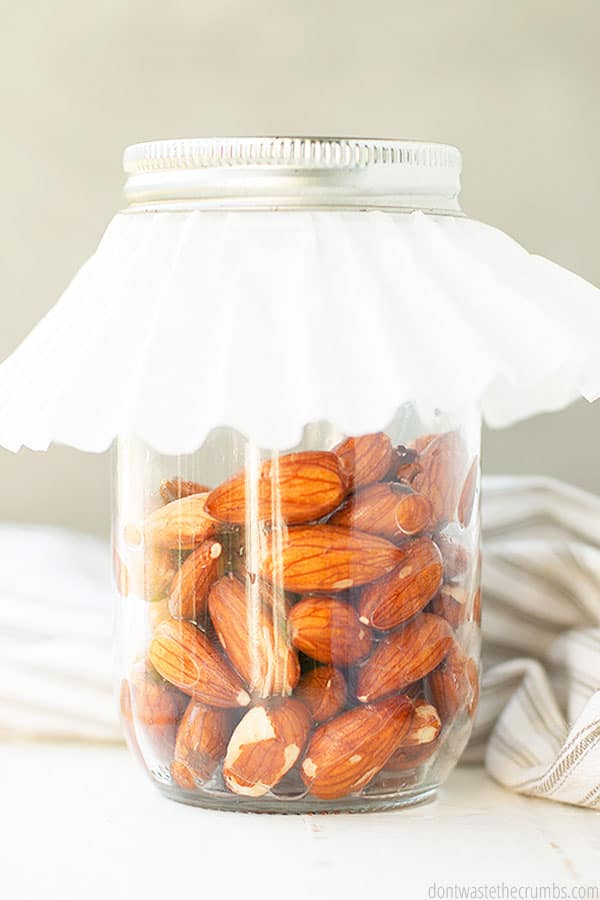
My Food is Alive – Now What?
- Once you sprout grains, you can use them immediately in dough recipes. Or you can dehydrate them to make flour (even without a mill).
- You can eat nuts and seeds wet or added to smoothies to boost protein. Or you can dehydrate them into crispy nuts or crispy seeds. Another option is to dehydrate and grind nuts into flour or meal for recipes (almond meal is an easy way to boost protein in a standard granola bar).
- Sprouted beans can be soaked to reduce phytic acid even more, and then cooked over several hours on low. I use this method here for soaking and cooking. And sometimes even cook in my slow cooker!
- At the end of the day, if I can increase the nutrients my family eats, I’m all for it. Because if I can get them to eat beans, then I want them to get everything they can out of them!

30 Minute Dinners Sample Meal Plan
Sign up to get instant access to my 30 Minute Dinners Sample Meal Plan, complete with recipes and step-by-step instructions!What’s your experience with sprouting? Do you think it’s something you could incorporate in your kitchen routine?

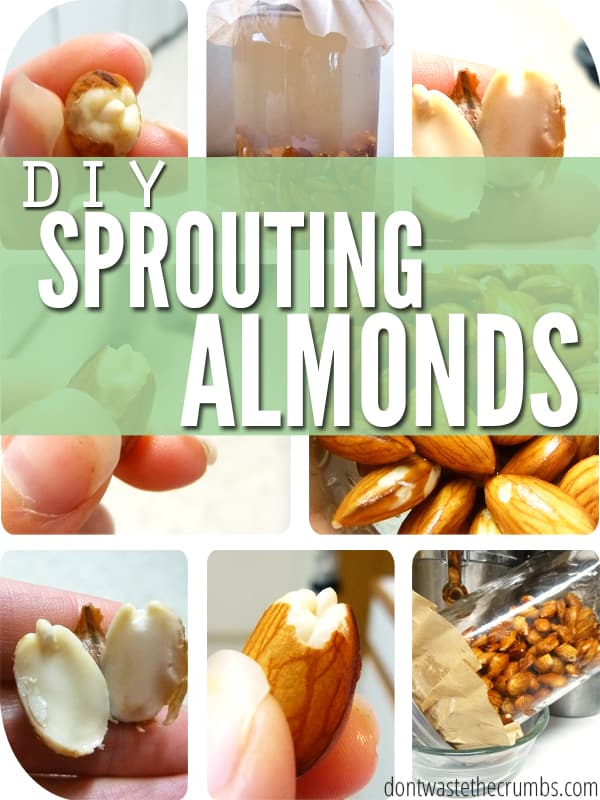
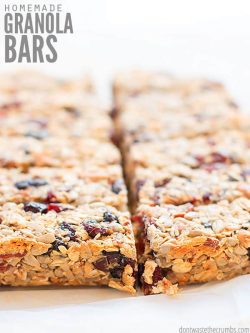

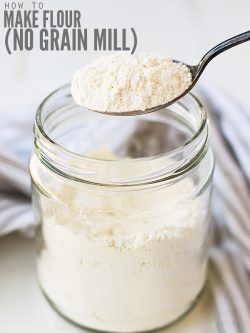
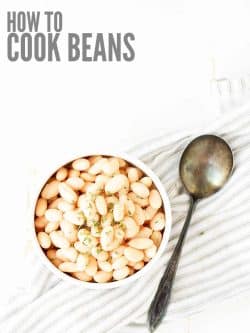

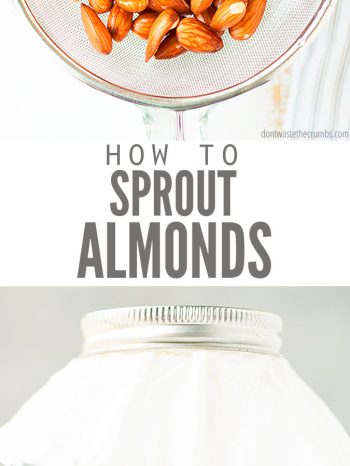
Hi
Great info – very excited about sprouting my almonds!!!
I am wondering what the optimal sprouting period is for almonds. I have searched around and I can’t find any info on this.
For example – wheat grass is optimal at about 6 days, having converted the starch into proteins etc
Do you know what the deal is with almonds
Hello Matthew,
It’s best to allow the almonds to sprout for 2-3 days.
It appears that some of the almonds have dark spots on them after two days of sprouting. Is this mold? And should I throw them away?
Mine haven’t had dark spots, but I wouldn’t think it was mold if you were changing the water regularly. If they smell ok, I’d say keep going!
I have also noticed dark spots after soaking – I’m not sure of the cause, but they taste fine!
Hi Tiffany,
I soaked almonds for two days and they sprouted, I skinned them and tasted some and they have a fermented taste to them, no almond flavor at all. I put them in the oven on low for over 24 hours to dry and they still have the that taste. Is that the way they should taste, or did I do something wrong?
How do I store the dried almonds and what is their shelf life?
Thank you
Chris
Hi Christina! My sprouted almonds didn’t taste fermented, but maybe you have a sensitive palate! Once they’re dry, you can store them in a jar in the pantry like you would ordinary almonds.
Thank you, but what do yours taste like? Do they still have the almond flavor?
Hi Tiffiny, i am teying to understand process of speouting almond. Why coffee filter required?. Can i close with jar lid for overnight?. Filter inside jar and close with lid?. Is it to get some air while soaking?
Hey Tiffany! I know this is an older post, but I just wanted to let you know I appreciate all the time and energy you put into making this post and all of your other posts as well! I’m restarting my journey to wellness and since it’s been about a year since I last sprouted almonds, I searched for a how-to and came across your blog! I noticed a lot of people asked about PPO and were looking for an alternative. Fred Meyer and Trader Joe’s bulk almonds both use the steam method; my almonds from Fred’s are actually soaking as I type this. Also, buying at farmer’s markets lets you ask the farmer. I’ve gotten great deals on steam-pasteurized almonds from farmer’s markets in multiple states (not as low as Costco prices but below Safeway/Harris Teeter/Publix prices). Anyways, thanks again for the work you put into your blog! I know I’ll be reading from it quite a bit!
I bulked up on organic raw almonds when they were on sale at our local health food store and promptly put them in the freezer. Will the thawed-out raw almonds sprout?
They should!
Have you ever used sprouted almonds to make vegan nut cheese?
No, I have not.
I’m going to try it. I make fermented almond cheese.
Go for it! Let us know how it goes! 🙂
This was a great article and helpful. Thank you so much
Hi there, can you clarify the process. I’m supposed to only fill with water the 1st night then rinse and let drain at an angle all day/night until the next morning rinse again and drain all day/night? Is that correct? What temperature should they drain at? I live in Hawaii and it gets pretty hot here. Should I do this in the refrigerator? Thank you!
Hi Hawaii3s! You are correct. They should drain at room temp, 68-80 degrees. If it’s warm in the house, maybe find a cool spot in a pantry? The fridge might be a little too cool. If anything, warm temps will just make the process go faster!
Hello, Tiffany. I soaked some Blackeyed Peas and they sprouted. They taste rather nice. But I am concerned whether or not they are a GMO. When I buy Blackeyed Peas in the store, is there a way to tell if they are GMO?
Hi Tom – the only way to know if they’re non-GMO is if the package states so… it would be labeled, similar to how organic is labeled. If you don’t see it, then it’s not non-GMO.
Is there a procedure that we can do to get rid of PPO as I buy Kirkland brand too ?
Not that I know of Khulud.
What is PPO? I buy them from Costco as well
Claudia,
Can you elaborate on your question about PPO? I’m sorry, I don’t know what you’re referring to. Thank you! Let me know and I will see if I can help. 🙂
Thank you for your answer! So would you say it’s pointless so sprout the almonds if you’re going to make yogurt out of them? Or are there still some benefits?
You’re welcome! There are still some benefits, and you can make yogurt from raw milk while heating to only 105-110 which doesn’t kill the enzymes. Is there a reason for heating the milk any higher in your recipe? If not, I’d start with a lower temp and see how it turns out!
Hi!
Thank you so much for your post!. Question- I’ve been sprouting my almonds for a while in order to make almond milk. With that sprouted almond milk I often make yogurt, but in order to make yogurt, I need to boil that milk first for a couple of seconds. My question is, will boiling sprouted milk kill all the enzymes, essentially making it pointless to sprout the almonds if I’m going to use them to make yogurt? But then I thought, if you use sprouted flour to make bread, it will get really heated in the oven too, right? I’d really appreciate your insight on this- can’t really find an answer anywhere:-)
Hi Iza! The short answer, yes – boiling sprouted will kill all the enzymes. When you bake bread, the temperature of the bread reaches 220F. This is high enough to kill some enzymes, but not all of them. There’s also the idea that sprouting actually changes the make-up of the food itself, so that in a sprouted state, the food is more easily digestible. I hope this helps!!
I agree with your article however it doesn’t list any supporting documents to validate your statements:
Sprouting seeds, grains, nuts and beans can give life to our dead food and help alleviate these problems and provide so many other benefits:
produces Vitamin C
increases vitamins B2, B5 and B6
increases carotene
neutralizes phytic acid
neutralizes enzyme inhibitors
breaks down complex sugars that cause intestinal gas
predigests some starches into sugar
inactivates the potent carcinogen aflatoxin
produces additional enzymes that aid in digestion
Can you please let me know what your sources were for this ? I have not been able to find specific chemical analysis of seeds/nuts/grains before and after sprouting to validate this.
Thank you
Could you provide a resource to find raw almonds? This has become difficult in the USA. Is there a place where customers can buy online say from Italy?
I was using Costco almonds too, but I decided to call them to ask how their almonds were pasteurized. They use a horrible chemical called PPO. When I asked, the man immediately said, “It’s PPO, the stuff nobody wants to hear is being used.” I was so disappointed because Costco is a cheap source of what I thought were great almonds. PPO is so nasty it was banned by both the American Motorcycle and the National Hot Rod Associations, where it had been used as a fuel before they recognized how dangerous it actually was. PPO is a verified carcinogen that is highly flammable with noxious fumes that are incredibly hazardous to a human beings personal health. Even the EPA has declared PPO a carcinogenic chemical that is responsible for neurological, gastrointestinal, respiratory, immune system dysfunctions and liver disease. Yikes, right? So I am still searching for almonds that are healthy and won’t kill us financially. I anyone has a good source, please share! 🙂
Interesting Melanie… do you have any links to research articles to share? I’d like to read more on this!
A tip for soaking chickpeas or other beans:
1tbs baking soda
1-2lb chickpeas
water
Soak 8-12h, and then cook your way with prefered herbs and spices, but reduce cooking time to 5 minutes. (The baking soda takes care of softening the peas!)
Hi! I am a little unsure on how to do this. Do you soak the almonds in water EVERY night, or just the first night, but rinse the almonds in fresh water every morning?? Thanks!
Hi Carly! You fill it with water on the first night, then rinse each day after.
Thanks! One more question…I have been doing this, and this morning I woke up to a spider web looking stuff around them…assuming it is mold of some sort. Is this supposed to happen?! Are they ok to eat?
Mine ended up rotting. I am quite disappointed and discouraged. I don’t know what I did wrong and almonds aren’t cheap. 🙁
I threw mine out too. I sprout seeds all the time. Before I try sprouting almonds again, I’ll look for a source that doesn’t pasteurize them.
Adding the word “raw” to your recipe above, e.g. “2 cups raw almonds,” might save your readers some frustration. I recently became a devoted nut sprouter, and I’m making homemade almond milk once a week from a simple recipe I adapted from one found online. You’re so right, the soaked, sprouted almonds are 10 times more delicious and (for me) digestible than roasted nuts. You can taste the sweet life force. I’m going to try sprouted cashew milk next! Thanks!
Hi Kerry! The reason I didn’t add raw to the ingredients is because the majority of nuts sold in the US are from California and the state requires pasteurization (the type left up to the manufacturer). So, the chances of your nuts being truly raw are not high, BUT at the same time, I’ve bought almonds from Costco that weren’t raw and sprouted them without a problem… see the dilemma?
But LOVE sprouted nuts! You reminded me that I need get back on this band wagon. Thanks Kerry!!
Can you share how you make your almond milk please?
Hi Claudia,
Here is my post that will show you how to make almond milk. Hope this helps. 🙂 https://dontwastethecrumbs.com/dairy-alternative-homemade-almond-milk/